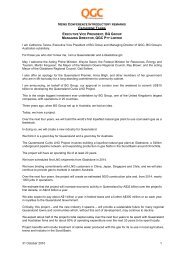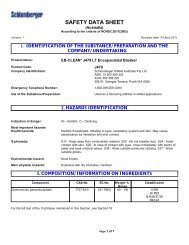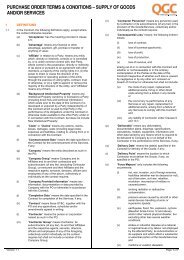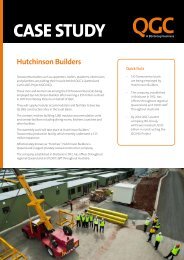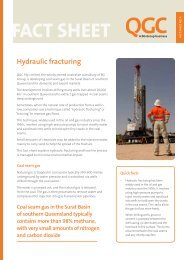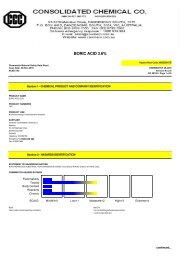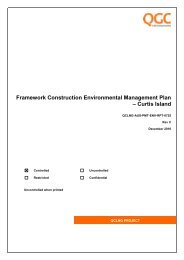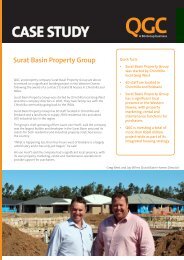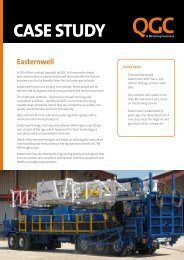Pest and Weed Management Plan - QGC
Pest and Weed Management Plan - QGC
Pest and Weed Management Plan - QGC
You also want an ePaper? Increase the reach of your titles
YUMPU automatically turns print PDFs into web optimized ePapers that Google loves.
<strong>Pest</strong> <strong>and</strong> <strong>Weed</strong> <strong>Management</strong> <strong>Plan</strong>Rev 0May 2011impacts by competing for food or destroying crops, as well as environmental impacts, including reductionof biodiversity, impacts on the l<strong>and</strong>scape <strong>and</strong> degradation of water quality.The DEEDI recommends control <strong>and</strong> reporting on non-declared pest animals. <strong>Management</strong> of thesepests requires coordination <strong>and</strong> they are subject to programs led by regional government, industry <strong>and</strong>/orl<strong>and</strong>owners.In Queensl<strong>and</strong>, the Fisheries Act 1994 (Fisheries Act) is the relevant legislation regarding noxious fishpests. The Fisheries Act provides legislative measures to manage pest fish <strong>and</strong> address the impacts theyhave on the economy, the environment <strong>and</strong> society. The DEEDI administers the noxious pest provisionsof the Act <strong>and</strong> its regulation.In line with the federal government, under the Fisheries Act 1994 the state government can declare anyfish that is or may become a pest to native aquatic communities. For example, European, Mirror <strong>and</strong> KoiCarp, Cyprinus carpio, is a declared noxious fish <strong>and</strong> may not be kept, sold or brought into the state <strong>and</strong>may not be released or used as bait in Queensl<strong>and</strong> waters. L<strong>and</strong>owners (including <strong>QGC</strong>) are required tocontrol any possible release of noxious fish from their impoundments.4.2 General <strong>Pest</strong> <strong>and</strong> Waste <strong>Management</strong> <strong>and</strong> Monitoring Measures4.2.1 Preliminary <strong>Pest</strong> IdentificationPreliminary pest surveys may be undertaken, usually in conjunction with vegetation surveys, to identifythe abundance <strong>and</strong> distribution of pest species across <strong>QGC</strong> tenements <strong>and</strong> adjacent l<strong>and</strong>s. Preclearancesurveys are also being undertaken across the <strong>QGC</strong> Gas Fields (mainly through ProjectEnvironmental Clearances) by Field Environment Officers (FEO) that identify <strong>and</strong> record the presence offeral animals. This information will then be included into <strong>QGC</strong>‟s Constraint <strong>Plan</strong>ning <strong>and</strong> FieldDevelopment Protocol (the Protocol).Incidental identification of pest distribution such as signs of feral pig activity may be discovered duringthese preliminary surveys. High abundance <strong>and</strong> distribution of pest species will be noted <strong>and</strong> may beused to generate special conditions of access or controls for gas field activities. A survey of <strong>QGC</strong> ownedtenements has been conducted <strong>and</strong> incidental identification of pest activities has been recorded.Information from these surveys has been accounted for in this document.4.2.2 L<strong>and</strong> Owner/Manager Consultations<strong>QGC</strong> representatives undertake consultations with l<strong>and</strong>owners on a regular basis. Preliminaryconsultation forms such as the Property Evaluation Reports (PER) have been developed for l<strong>and</strong> ownerconsultations <strong>and</strong> weed <strong>and</strong> pest distributions <strong>and</strong> management programs are covered in these reports.Information such as the presence of feral animals on the property or neighbouring properties <strong>and</strong> anyferal animal management programs in place will be recorded. Information on distribution of feral animals36 of 100



